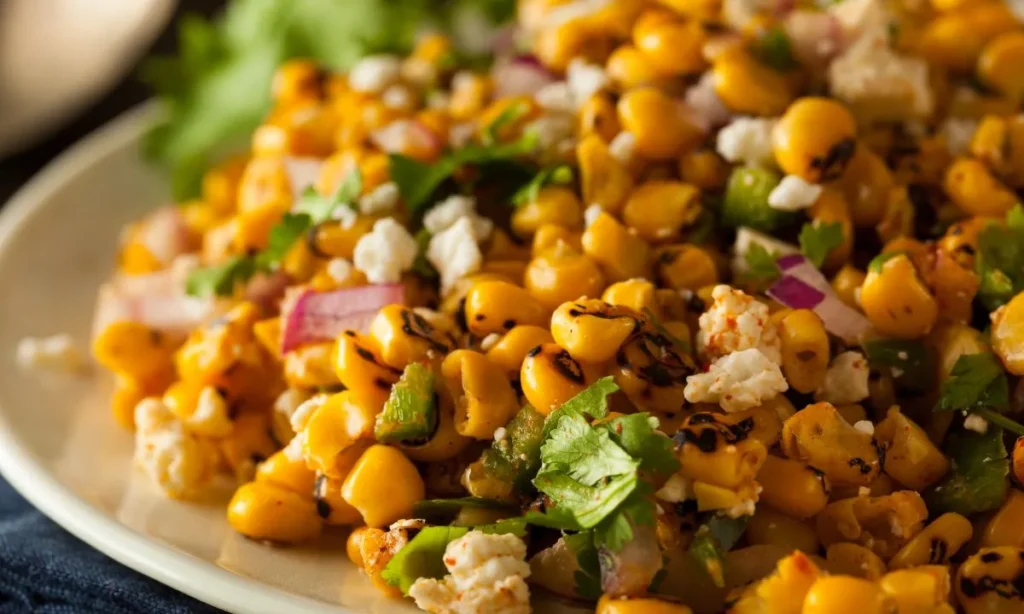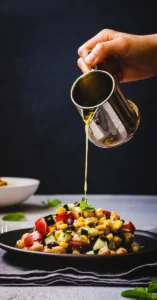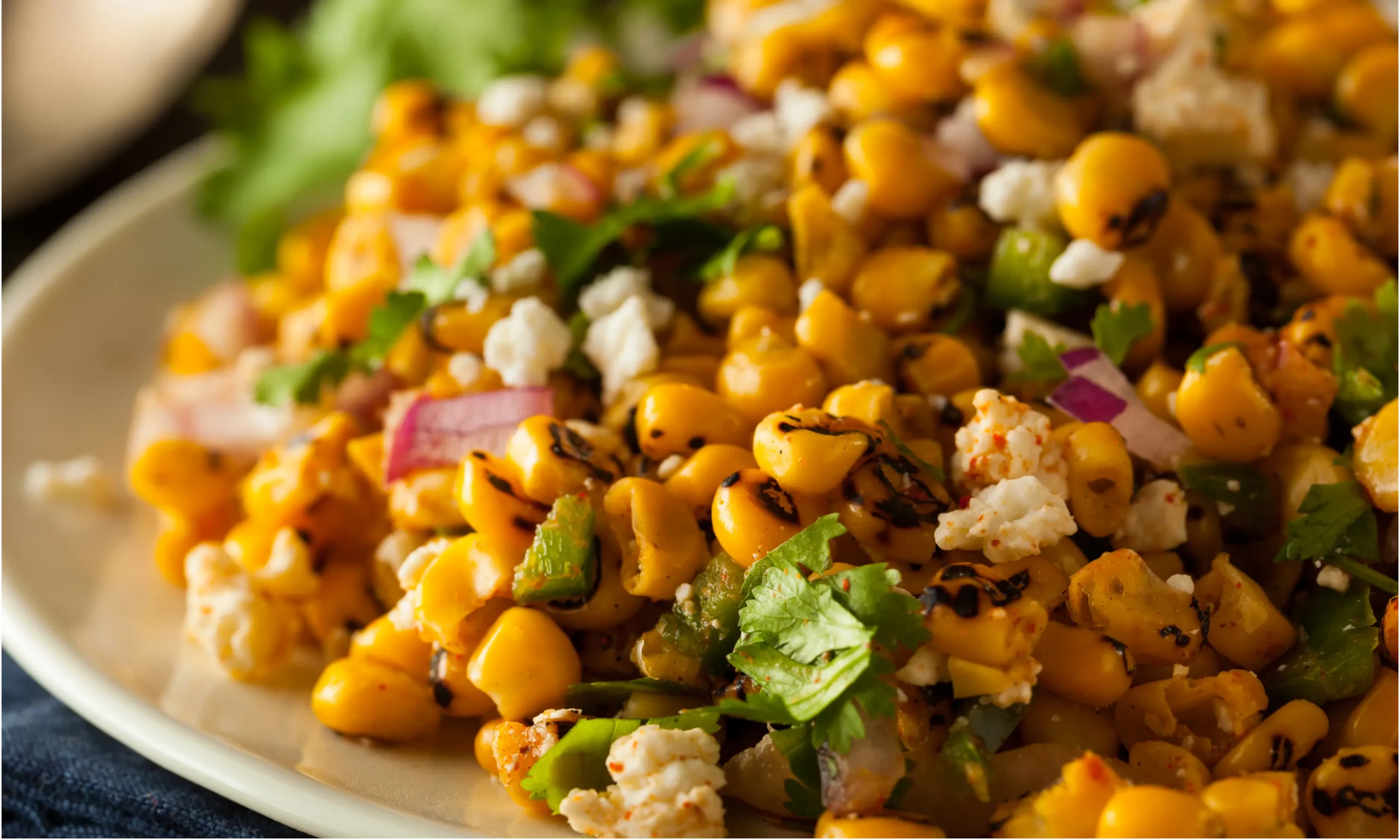
Introduction to Mexican Corn Salad with Canned Corn
Discover the vibrant world of Mexican Corn Salad, celebrated for its easy preparation with canned corn. You can enjoy this delightful salad anytime, thanks to its simple ingredients. This guide covers everything from Mexican Corn Salad’s origins and cultural impact to expert advice on enhancing its flavors and creative ways to serve it. Whether you’re just starting or an experienced chef, you’ll find all the information you need to introduce authentic Mexican flavors to your table.
Moreover, by exploring Mexican corn salad, you’ll learn how to prepare it and customize it with various adaptations. This guide will also explain why this dish is so valued in Mexican cuisine and how you can present it in exciting new ways. Get ready to add a fresh, zesty twist to your meals with this beloved salad.
Understanding the Rich History and Cultural Significance of Mexican Corn Salad
Corn has been a staple in Mexican cuisine and a cornerstone of its culture, dating back to the ancient Aztecs and Mayans. Revered not just as a food source but also as a spiritual element, corn is featured in many myths, including those that describe it as a gift from the gods. This deep respect for corn is reflected in various dishes that have evolved over the centuries, each region adding its twist and flavor. Mexican Corn Salad, or Esquites, is a modern adaptation that brings the ancient love for corn into contemporary Mexican kitchens and beyond, offering a historical and freshly delightful taste.
Cultural and Event Significance
Moreover, Esquites are more than just a dish; they are part of the Mexican social fabric and are often enjoyed during festivals, markets, and street fairs. Its portability and ease of eating make it a popular choice at small family gatherings and significant community events. The dish celebrates corn’s integral role in Mexican cuisine and cultural identity.
Regional Variations
In Oaxaca, Esquites often feature local herbs and spices, which infuse the dish with distinctive regional flavors. During local celebrations, chefs might enhance the salad with pomegranate seeds, adding a vibrant burst of color and sweetness that highlights the area’s seasonal produce.

Dietary Categorization
This salad easily adjusts to various dietary needs. It’s naturally gluten-free and can be made vegan using vegan mayonnaise and omitting the cheese. For those on a low-calorie diet, substituting mayonnaise with yogurt or low-fat sour cream can significantly lower the calorie count. Furthermore, adding ingredients like avocado or beans enhances its suitability for a vegetarian diet, providing a nutritious meal rich in plant-based proteins and essential nutrients.
Health Benefits and Dietary Considerations of Mexican Corn Salad
Mexican Corn Salad delights the taste buds and offers many health benefits, making it a nutritious choice for any meal. Corn, the primary ingredient, serves as an excellent source of dietary fiber, which aids in di
gestion and maintains a healthy gut. It also supplies essential minerals such as zinc, magnesium, copper, iron, and manganese, which are crucial for overall health and well-being.
Corn is rich in B vitamins, crucial for energy production and optimal nerve function. Additionally, adding lime juice to the salad enhances its flavor and significantly improves the body’s ability to absorb iron from the corn and other plant-based ingredients. This is particularly beneficial for those on vegetarian or vegan diets, ensuring they receive enough iron, which is essential for overall health.
Moreover, the antioxidants in chili powder and lime juice deliver additional health benefits. These antioxidants help combat oxi
dative stress and reduce inflammation, potentially preventing chronic diseases. Capsaicin, from the chili peppers used to make chili powder, has potential benefits for metabolism, possibly aiding in weight loss and improving cardiovascular health.
Mexican Corn Salad is highly accommodating for those with dietary restrictions or preferences. Naturally gluten-free, it suits those with celiac disease or gluten sensitivity. Easily adaptable for vegan diets, you can substitute dairy ingredients with plant-based alternatives such as vegan mayonnaise or omit cheese.
This versatile salad enriches your diet with its flavorful profile and supports a healthy lifestyle with its nutrient-rich ingredients. Wh
ether you’re seeking a light side dish or a hearty main, Mexican Corn Salad can be a delicious and healthful part of your dining experience.
Detailed Ingredient Breakdown
Lime Juice: Adds a bright, tangy flavor that balances the sweetness of the corn. It’s also packed with vitamin C, which can boost immune health.
Chili Powder: This blend of spices provides a mild heat and complexity that can vary depending on the mix. It typically includes chili peppers, garlic powder, and other spices, each contributing its layer of flavor.
Cotija Cheese: A salty, crumbly cheese that adds a depth of flavor. If cotija is unavailable, feta or parmesan can be substitutes, although each will slightly alter the salad’s traditional taste.
Cooking Techniques and Tips
The perfect char on the corn involves h
igh heat and the right pan—preferably a heavy cast-iron skillet. To achieve the perfect char on your corn, it’s essential to let it sit undisturbed on a hot pan for a few minutes. This method allows the corn to develop those sought-after golden-brown marks that enhance its flavor. If you’re making your own mayonnaise for the dressing, combine egg yolks with a squeeze of lime. Gradually drizzle in oil while whisking vigorously. This process emulsifies the mixture, resulting in a rich, creamy base that perfectly complements the salad.
How to Prepare Mexican Corn Salad
Preparing Mexican Corn Salad with canned
corn combines traditional flavors in simple steps. This detailed breakdown provides clarity on each phase of preparation.
Draining and Preparing the Corn
First, drain the canned corn thoroughly to ensure the salad isn’t waterlogged. For a more intense flavor, lightly char the corn in a dry skillet over medium-high heat. This step adds a smoky depth to the salad, mimicking the traditional grilled flavor of street corn.
Making the Dressing
Second, whisk together mayonnaise, fresh lime juice, and chili powder in a small bowl. This creamy dressing will act as the binding agent for the salad, with the lime juice adding a necessary zesty kick that balances the sweetness of the corn.
Combining the Ingredients
Third, combine the charred corn with finely chopped cilantro and diced jalapeños (optional, for heat) in a large mixing bowl. Pour the dressing over the corn mixture and mix thoroughly to ensure all ingredients are well-coated. If desired, crumble cotija cheese over the top for a salty, cheesy finish that complements the creamy dressing.
Final Adjustments
Lastly, taste and adjust the seasoning of your salad, possibly adding more lime juice for acidity or a pinch of salt. This step ensures that all the flavors meld together harmoniously.
By following these steps, you can create a delightful Mexican Corn Salad that’s easy to prepare and flavorful.
Serving It Up
Serving the Mexican Corn Salad can vary depending on the occasion and personal preferences. Here’s how to make the most out of this versatile dish.
As a Main Dish
First, Mexican Corn Salad can stand alone as a light, refreshing main course. Enhance it with shredded chicken or grilled shrimp to make it more substantial. This is perfect for those warm summer evenings when you want something hearty but not heavy.
As a Side Dish
Second, this salad pairs beautifully with a variety of Mexican dishes. Serve it alongside tacos, burritos, or enchiladas to add a fresh, creamy element to your meal. It’s trendy during barbecues and family gatherings.
As a Dip
Lastly, consider serving Mexican Corn Salad as a unique and flavorful dip. Serve it in a bowl surrounded by tortilla chips. Guests can scoop the salad with chips for a delightful and interactive appetizer.
Pairings and Occasions
Mexican Corn Salad pairs beautifully with grilled meats and seafood, making it a versatile barbecue side dish. It’s also a festive dish for Cinco de Mayo or Dia de los Muertos, complementing other traditional foods like tamales and mole. As a dish served cold, it offers a refreshing contrast to the warm, spicy flavors typically found in Mexican cuisine.
Exploring Regional Variations of Mexican Corn Salad
Mexican Corn Salad showcases remarkable versatility, reflecting the diverse regional tastes across Mexico. In regions rich with avocados, chefs add this creamy fruit to enrich the texture and flavor, enhancing the salad’s appeal. In regions where beans are a staple, chefs often include black or pinto beans for added protein, thereby making the dish more satisfying. Furthermore, these local adaptations do more than cater to regional tastes; they also showcase the unique agricultural outputs specific to each area. Consequently, each version of Mexican Corn Salad tells a compelling story of local flavors and traditions and illustrates the dish’s ongoing evolution while maintaining its deep-rooted cultural significance.
You’re Thinking About Trying It! Aren’t You?
We invite all our readers to dive into the vibrant world of Mexican cuisine by participating in a Mexican Corn Salad recipe challenge. This is your chance to personalize this classic dish, using your favorite local ingredients or experimenting with new flavor combinations. Share your unique creations online to inspire others and showcase your culinary skills. Engaging with the community in this way enriches our collective understanding of food and celebrates our readers’ creativity and diversity. Each variation helps evolve Mexican Corn Salad, showing how traditional recipes can adapt and thrive in modern kitchens. Join this culinary adventure, share your experiences, and connect with fellow food enthusiasts!
For more information on the nutritional benefits of corn, visit NutritionData, explore the historical significance of corn in Mexican culture at History.com, and for a deeper dive into Mexican culinary traditions, check out Mexican Cuisine.

